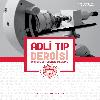Adli otopsilerde kalp ağırlığının değerlendirilmesi
Evaluation of heart weights in forensic autopsies
___
- 1. Kumar V, Abbas AK, Aster JC. Robbins Basic Pathology, 10th Edition. Vol. 10. 2017. 414 p.
- 2. Aschoff L. Lectures on pathology. 1924. p. 365.
- 3. Molina DK, DiMaio VJM. Normal Organ Weights in Men. Am J Forensic Med Pathol. 2012 Dec;33(4):362–7.
- 4. Molina DK, DiMaio VJM. Normal Organ Weights in Women. Am J Forensic Med Pathol. 2015 Sep;36(3):176–81.
- 5. Hangartner JR, Marley NJ, Whitehead A, Thomas AC, Davies MJ. The assessment of cardiac hypertrophy at autopsy. Histo- pathology. 1985 Dec;9(12):1295–306.
- 6. Skurdal AC, Nordrum IS. A retrospective study of postmor- tem heart weight in an adult Norwegian population. Cardio- vasc Pathol. 2016 Nov;25(6):461–7.
- 7. Ogiu N, Nakamura Y, Ijiri I, Hiraiwa K, Ogiu T. A Statistical Analysis of the Internal Organ Weights of Normal Japanese People. Health Phys. 1997 Mar;72(3):368–83.
- 8. Hanzlick R, Rydzewski D. Heart Weights of White Men 20 to 39 Years of Age. Am J Forensic Med Pathol. 1990 Sep;11(3):202–4.
- 9. Kitzman DW, Scholz DG, Hagen PT, Ilstrup DM, Edwards WD. Age-Related Changes in Normal Human Hearts During the
- First 10 Decades of Life. Part II (Maturity): A Quantitative Ana- tomic Study of 765 Specimens From Subjects 20 to 99 Years Old. Mayo Clin Proc. 1988 Feb;63(2):137–46.
- 10. Gaitskell K, Perera R, Soilleux EJ. Derivation of new refer- ence tables for human heart weights in light of increasing body mass index. J Clin Pathol 2011 Apr 1;64(4):358–62.
- 11. Hayes JA, Lovell HG. Heart Weight of Jamaicans. Circula- tion 1966 Mar;33(3):450–4.
- 12. de la Grandmaison GL, Clairand I, Durigon M. Organ weight in 684 adult autopsies: New tables for a Caucasoid population. Forensic Sci Int 2001 Jun;119(2):149–54.
- 13. Dadgar SK, Tyagi SP, Singh RP, S. H. Factors Influencing The Normal Heart Weight: A Study Of 140 Hearts. Jpn Circ J 1979;43(2):77–82.
- 14. Zeek PM. Heart weight - 1 the weight of the normal human heart. 1942;34.
- 15. Vanhaebost J, Faouzi M, Mangin P, Michaud K. New refer- ence tables and user-friendly Internet application for predict- ed heart weights. Int J Legal Med 2014 Jul 11;128(4):615–20.
- 16. Smith HL. The relation of the weight of the heart to the weight of the body and of the weight of the heart to age. Am Heart J 1928 Oct;4(1):79–93.
- 17. Cunha DF da, Cunha SFDC Da, Reis MA Dos, Teixeira VDPA. Heart Weight and Heart Weight/Body Weight Coefficient in Malnourished Adults. Arq Bras Cardiol 2002 Apr;78(4):382–7.
- 18. Standring S, Borley NR, Collins P, Crossma AR, Gatzoulis MA, Healy JC. In: Gray’s Anatomy. Elsevier; 2008.
- 19. Fulton RM, Hutchinson EC, Jones AM. Ventricular weight In cardiac hypertrophy. Heart 1952 Jul 1;14(3):413–20.
- ISSN: 1018-5275
- Yayın Aralığı: 3
- Başlangıç: 1985
- Yayıncı: BAYT Yayıncılık
Sekel bırakarak iyileşmiş tibia ve talus kırıklarında maluliyet değerlendirmesi: Bir olgu sunumu
Medyar KOÇAK, Mehmet ÖZBAY, Arif GARİBOĞLU
Ebelik öğrencilerinin adli ebelik ve adli vakalarla ilgili bilgi ve görüşlerinin belirlenmesi
Reyhan AYDIN DOĞAN, Esra YILMAZ
Adli otopsilerde kalp ağırlığının değerlendirilmesi
Muhammed Emin GÖKŞEN, Murat Nihat ARSLAN, Taner DAŞ, Ferah KARAYEL
An unusual decapitation injury
Ashwini KUMAR, Navdeep KAUR, Rajiv JOSHİ, Harvinder Singh CHHABRA
Travma sonrası gebelik sonlanmasının adli tıbbi yönü
Ümit Naci GÜNDOĞMUŞ, Ceyhun KÜÇÜK, Pınar BAKIR KÜÇÜK, Murat Nihat ARSLAN
